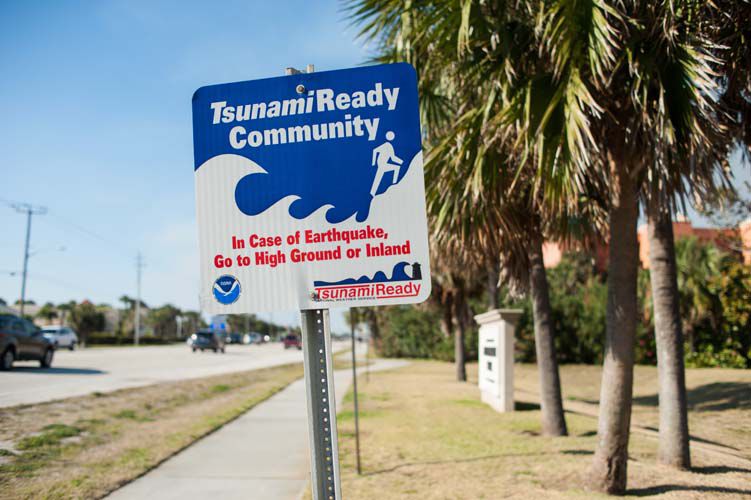At the southern entrance of Millennium Beach Park on A1A in Indian Harbour Beach, a small sign planted on the side of the road can’t help but catch people’s attention. It reads Tsunami Ready – but the initial instinct is to wonder if the threat of a tsunami is any more real than the threat of a Martian invasion.
Those in the know assure us that the threat is very much real but not so much from monster waves wiping out everything in their path from ocean to river. Rather the threat comes from waves rippling across miles and miles of sea before arriving here with currents that are ten times the strength of the most powerful rip current and can flood the beach to boot.
That possibility leads NOAA to hold an annual readiness drill for public safety officials on the coast. The drill took place in March and featured various scenarios, including a tsunami hitting Portugal, mimicking one that struck that country 1755, killing 60,000 and eventually reaching the coast of Florida.
“We calculated that tsunami created five foot waves in Florida,” said George Maul, professor of ocean engineering and science at the Florida Institute of Technology and former chairman of the department of marine and environmental systems.
The ripple effect of the 2004 tsunami in Indonesia that killed more than 230,000 left its mark in Port Canaveral, extending a distance of 11,000 miles. That’s one powerful storm, even if the wave produced here was just a foot high with no damage.
According to the Brevard County office of emergency management, tsunamis are a series of waves following an underwater disturbance such as an earthquake, landslide, volcanic eruption – or even a meteorite. From the area where the tsunami originates, waves travel outward in all directions. Tsunami waves move up to 500 mph over the open ocean, then slow considerably as they approach coastal areas.
“Not every earthquake creates a tsunami. You need at least a 6.5 to 7 on a Richter scale,” Maul said.
In the aftermath of the 2004 carnage, President Bush ordered the Commerce Department to address the impact of a tsunami on the eastern seaboard. When the National Weather Service sought a community in Brevard County for a pilot project more than a dozen years ago, Indian Harbour Beach volunteered and created a plan to become tsunami ready.
“One reason the city took on this responsibility was because natural disasters are accruing more often than ever,” said Indian Harbour Beach Fire Chief, Todd Scaldo. “We are located next to the Atlantic Ocean so the plan to us was a no brainer. This gives us another tool to help warn residents and visitors who use the beach on a regular basis. The extra costs were nominal: bullhorns, concrete poles, beach park sirens, warning lights and signage.”
Based on the readiness plan, persons in the water, on the beach and on the first floor of beachside homes and condos need to be evacuated. “If we receive a tsunami warning, all available city personnel will be assigned a zone they are responsible for in terms of evacuation,” Scaldo said.
Maul said the most important natural signals of an impending tsunami – that mean GET OFF THE BEACH! – are water suddenly drawing down or surging. “If the waves are coming in very fast it won’t turn out well.”
The readiness drill that involved Portugal assumed an earthquake with a magnitude of 8 or higher. “It would affect the entire Atlantic Ocean. The impact would take six to eight hours to reach our coastline,” said Scott Spratt, warning coordination meteorologist for the weather service. “It’s not about wave height as it is about the power of the ocean current. An Olympic swimmer who can fight through the strongest rip current cannot fight this. If you’re knee deep and the current knocks you over you will not be able to stand up to walk back to the beach. That’s the danger.”
If the earthquake happened in the Puerto Rico trench it would take three hours to reach here. “But much of the wave energy would be blocked by the Bahamas so it would not be as significant,” Spratt said.
A third scenario based on an earthquake along the continental shelf not far off shore was strong enough to shake the land mass underwater resulting in a landslide in the shelf. That creates locally generated waves. From the time it’s identified, the effect would be felt in an hour or less, Spratt said.
The National Weather Service designates a community Tsunami Ready if it, like Indian Harbour Beach, defines tsunami hazard zones, produces evacuation maps and installs evacuation route signs; supports ongoing public education; establishes a 24-hour warning point with emergency operations; and has more than one way to receive tsunami warnings to alert the public.
Brevard County does all of the above activities, with the exception of the evacuation maps, hazard zone signs and evacuation route signs, said Kimberly Prosser, director of the Brevard County office of emergency management. “Whether or not the county is officially designated as Tsunami Ready, we do have plans in place and participate in annual exercises, so that we are prepared to respond if a tsunami occurs.”

